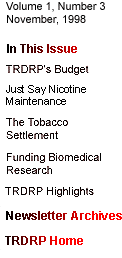
"Why Do You Fund Biomedical Research" or "Why Don't You Fund Biomedical Research Anymore?" by Jeffrey Cheek
"Why does TRDRP support basic (instead of only applied) biomedical
research?"
Biomedical research is currently undergoing an exponential growth explosion;
the challenge facing TRDRP and other research sponsors is how to best cultivate
that growth and facilitate its applicability towards improving public health.
In answering this challenge, there are two additional factors that influence
the nature of TRDRP-sponsored biomedical research. First, for proposals
that do not deal directly with tobacco use and/or control issues, TRDRP
imposes a relevance criterion on all funded projects. This guideline distinguishes
research specific to the underlying mechanisms, diagnosis or treatment of
tobacco-related disease from that which serves to advance our understanding
of basic biological principles. While it does not constitute judgement on
the scientific merit of a particular project, those applications deemed
by TRDRP staff to be insufficiently relevant to the Program's mission are
not forwarded for peer review, but are returned to the applicant with recommendations
for more suitable venues (e.g., NIH). It is important to note that a proposal
can be of a very basic nature, such as those utilizing molecular and cell
biological approaches, and still be highly relevant to TRDRP's research
priorities. Yet even within the biomedical field itself, there is an ongoing
debate as to whether the majority of resources should be focused on basic
vs. applied research. The public's appreciation of biomedical research is
obviously tilted toward the applied arena, as most of the prominent advancements
that enhance public health occur as a result of new therapies and treatments
for disease. Funding agencies like TRDRP need to keep in mind that basic
research leads to the discoveries of applied research, but these contributions
are far less intuitive and thus harder to appreciate.
Another reason for continued support of biomedical science by TRDRP is the serendipity of basic research - in other words, how the benefits of a discovery in one discipline may advance the "state of the art" in a separate, seemingly unrelated field. One of TRDRP's former investigators, Dr. Louis Ignarro of UCLA, is the recipient of the 1998 Nobel Prize in Physiology or Medicine for his work on identifying nitric oxide, a common air pollutant, as a signaling molecule made by the body to control the relaxation of blood vessels. Although the work for which he received the Nobel prize was conducted prior, two of Dr. Ignarro's subsequent TRDRP-funded projects examined the effects of inhaled nitric oxide, which is present in high amounts in cigarette smoke, on its normal production in vivo (see page 10). Some critics of the program denounced TRDRP for supporting these projects, since the clinical utility of such work was not certain at that time. Nevertheless, findings from these and other related studies increased our understanding of cardiovascular disease processes, particularly why smokers may be at greater risk for thrombosis and coronary heart disease. With respect to the serendipitous nature of basic research, a fortuitous elaboration of the work of Dr. Ignarro and other basic researchers resulted in the development of the male impotence drug Viagra®.
Given the recent federal debate over whether publicly-funded science must have instantaneous practical applications, Dr. Ignarro's efforts provide an excellent example of how an investment in basic science can, in relatively few years, lead to discoveries with far-reaching clinical relevance. However, while the serendipitous contributions of basic research reach beyond their immediate objectives, the cures to many of the diseases targeted by biomedical research remain elusive, as evidenced by the continuing war on cancer initially declared by the Nixon administration over two decades ago. Expedience demands that TRDRP maintain its support of both basic and applied biomedical science, coupled with behavioral and policy research, towards the goal of balancing immediate and long term benefits in the fight against tobacco-related diseases.
Archives |
Home | ||